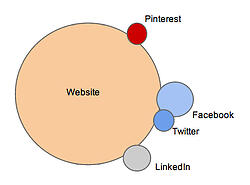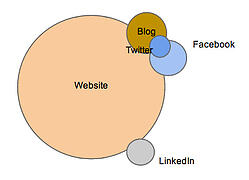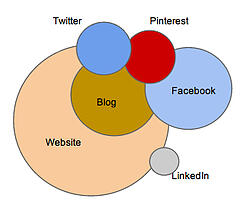Topics: Social Media Content Marketing Web Development
Your Social Ecosystem: Is It Driving More Traffic and Leads to Your Website?
 Author: Chris Heiler
Author: Chris Heiler
When we conduct an Inbound Marketing Assessment for a potential client we illustrate what we call a "social ecosystem" (tip of the hat to Jay Baer for this) that represents where the company is participating online and how these platforms relate to one another.
A typical social ecosystem
 A typical social ecosystem for a company will look something like this first illustration. The company has a website, perhaps with 10 to 15 pages, but no blog. The company has a Facebook Page and a Twitter account and has also just recently created an account on Pinterest. The owner of the company has a LinkedIn profile.
A typical social ecosystem for a company will look something like this first illustration. The company has a website, perhaps with 10 to 15 pages, but no blog. The company has a Facebook Page and a Twitter account and has also just recently created an account on Pinterest. The owner of the company has a LinkedIn profile.
Aside from the social media icons displayed on the company's website, the integration between website and social outposts is minimal. The company's social networks operate in silos--unconnected--except for Facebook updates automatically pushed to their Twitter account.

In this next example of a social ecosystem, also somewhat typical of our industry, the company has a blog to complement their more static website. The blog may or may not be hosted on the company website. If it is hosted on site, the blog's content is not tightly integrated with the website's pages. The blog doesn't contain strong call-to-actions (CTAs) and offers that support the website and the products and services offered by the company.
Blog posts (often too few in frequency) are automatically pushed to the company Facebook Page (and then on to Twitter). The same amount of attention is given to the company blog as is given to the Facebook Page. The Twitter account is mostly ignored; only updated occassionally by the automatic posts from Facebook.
The recommended social ecosystem
 This next illustration shows our recomended, or ideal, social ecosystem. The company blog is hosted on the website and all web pages and blog posts support one another with strong CTAs, offers and landing pages that generate actual leads.
This next illustration shows our recomended, or ideal, social ecosystem. The company blog is hosted on the website and all web pages and blog posts support one another with strong CTAs, offers and landing pages that generate actual leads.
Blog posts are added to the company Facebook Page and Twitter account separately. Relevant images from the blog posts and website are added to Pinterest. These images on Pinterest are then often shared on Facebook and Twitter.
Most attention is given to the company blog and Facebook Page while Twitter and Pinterest play a lesser role in the company's social strategy.
Benefits of an integrated social ecosystem
The benefits of this more tightly integrated social ecosystem are many, most importantly:
- More traffic is driven to the company website where qualified leads can be captured.
- Original, fresh content on-site leads to more inbound links and boosts search engine rankings.
- You pick up more followers in your social networks and connect with them on multiple platforms.
- Content creation becomes easier as you repurpose and cross-pollinate content on each social network.
Here's a key point: Success with social media and inbound marketing is not dependent on the number of social networks you are active on. We are not suggesting your business needs to participate on all the social networks illustrated here. You will find success in how tightly integrated your networks are and how they complement and support each other.
 Take a look at this social ecosystem. This company can effectively market themselves with only a website, blog and Twitter account. They don't have to be everywhere. Consistent blogging and regular participation on Twitter can be enough to increase traffic to their website and generate qualified leads for their sales team.
Take a look at this social ecosystem. This company can effectively market themselves with only a website, blog and Twitter account. They don't have to be everywhere. Consistent blogging and regular participation on Twitter can be enough to increase traffic to their website and generate qualified leads for their sales team.
We hope these illustrations get you thinking about your company's social ecosystem. Play around with this idea and map out your own ecosystem. How can you improve the integration between social platforms?





